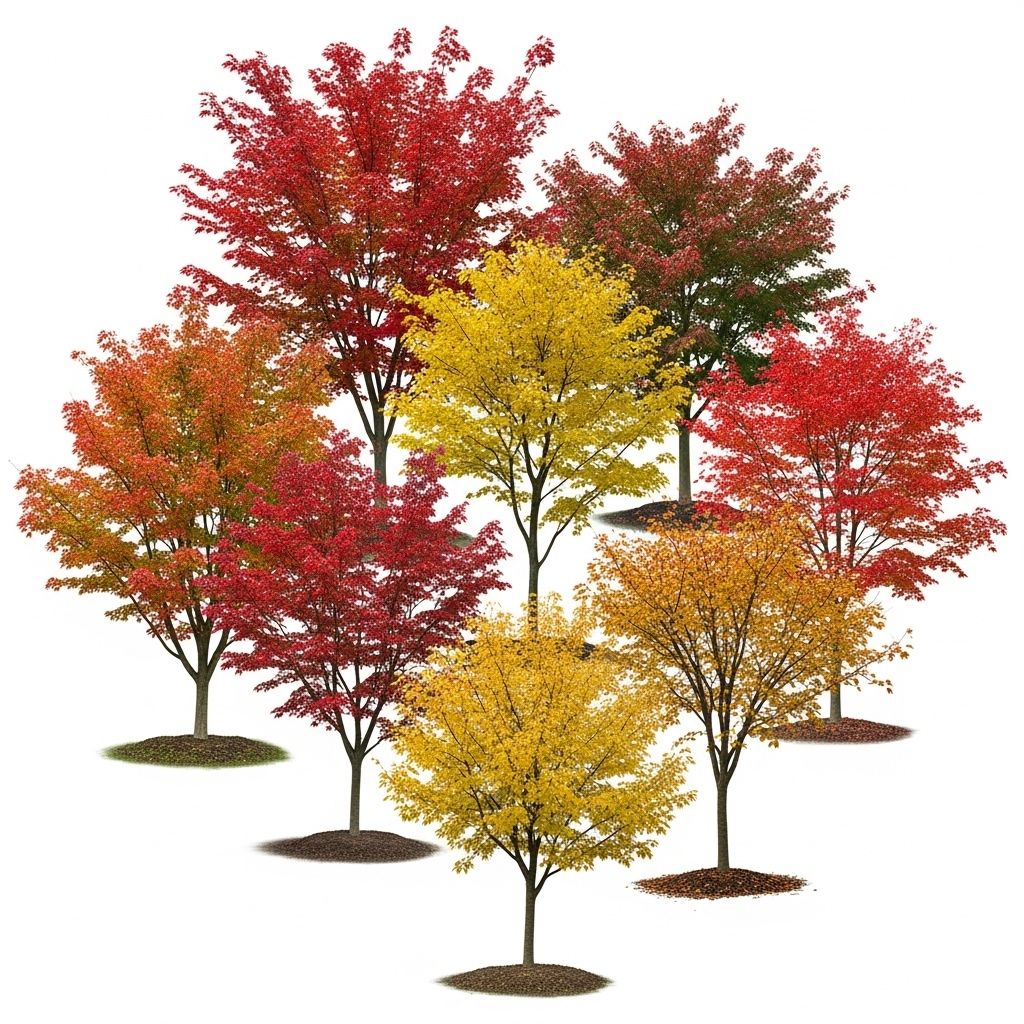7 Maple Trees That Thrive in Texas: Varieties, Care, and Identification
Hardy natives and shade-loving ornamentals guarantee vibrant autumn hues in warm gardens.

Image: HearthJunction Design Team
Introduction
Dreaming of brilliant autumn colors right in your Texas backyard? Maple trees are renowned for their stunning fall foliage and stately presence, but selecting the right variety is vital for Texas’s challenging climate. Whether you’re hoping to enjoy vibrant color from your window or simply want to identify native species on your property, this comprehensive guide covers seven of the best maple trees for Texas, including crucial information on their appearance, care requirements, and where they perform best.
Why Choose Maple Trees For Texas Landscapes?
Maples are prized for their:
- Striking Fall Foliage: From golden yellows to fiery reds, maples deliver some of the most spectacular seasonal color changes.
- Shade and Habitat: Large maple canopies offer cool shade and shelter for birds and wildlife.
- Adaptability: Certain maple species are well-suited for Texas’s varied climates and soil conditions.
- Versatility: Great for urban yards, country landscapes, and even container gardening (with the right species).
But not all maples thrive in Texas. The right choice depends on your location, local climate, and garden goals.
7 Maple Tree Varieties for Texas
Below are seven maple species that do well in Texan soils, from native varieties to ornamental imports. For each tree, we cover:
- Scientific Name
- Growth Habits and Appearance
- Best Texas Regions
- Notable Features and Care Tips
1. Box Elder Maple (Acer negundo)
- Leaf Retention: Deciduous
- Height: Up to 45 feet
- Fall Foliage: Yellow
- Light Requirement: Partial to Full Sun
- Water Use: High
- USDA Zone: 2-9
- Native Origin: North America
The Box Elder Maple stands out with its compound leaves, which often have three, five, seven, or even nine leaflets—making it easy to distinguish from other maples. Its unique trunk structure often features several trunks rather than a single main stem. Male and female trees both bear springtime flowers. Box Elder Maples favor the moist soils of East Texas and struggle in drought-prone regions. They are vulnerable to insect pests, especially the box-elder bug, and need consistently moist conditions to thrive.
2. Bigtooth Maple (Acer grandidentatum)
- Leaf Retention: Deciduous
- Height: 20-50 feet
- Fall Foliage: Yellow, Orange, Red hues
- Light Requirement: Full Sun to Light Shade
- Water Use: Moderate
- USDA Zone: 4-8
- Native Origin: Southwestern US, including Texas
One of Texas’s most treasured natives, the Bigtooth Maple brings dazzling autumn color to the Hill Country and West Texas canyons. Its leaves are classic maple-shaped with pronounced teeth, turning vivid shades in cool fall weather. Drought-tolerant once established, it prefers rocky or well-drained soils and can thrive in sun or partial shade. Bigtooth Maple is a superb choice for Texas landscapes seeking native resilience and beauty.
3. Red Maple (Acer rubrum)
- Leaf Retention: Deciduous
- Height: 40-60 feet
- Fall Foliage: Bright Red
- Light Requirement: Full Sun to Partial Shade
- Water Use: High
- USDA Zone: 3-9
- Native Origin: Eastern North America, including East Texas
Famed for fiery fall color, the Red Maple features leaves with three to five lobes and a distinctive reddish tinge to its twigs, buds, and samaras (seeds). This species flourishes in the moist soils of East Texas and is widely planted as an ornamental in urban landscapes. It requires consistent moisture and is less tolerant of drought compared to native maples, making it best suited for areas with reliable rainfall or irrigation. Red Maple seeds, leaves, and even bark bring a touch of autumn’s magic to any landscape.
4. Sugar Maple (Acer saccharum)
- Leaf Retention: Deciduous
- Height: 50-70 feet
- Fall Foliage: Orange, Red, Yellow
- Light Requirement: Full Sun to Partial Shade
- Water Use: High
- USDA Zone: 3-8
- Native Origin: Eastern North America
Sugar Maples are iconic for producing maple syrup and for their show-stopping autumn display. In Texas, they’re more often found as landscape trees in East Texas, where soils are deeper and rainfall is greater. Sugar Maples require consistently moist, well-drained soils and are not as drought-tolerant as some Texas natives. These trees grow large, so give them ample space, and protect them from the harshest afternoon sun in hot, western exposures.
5. Chalk Maple (Acer leucoderme)
- Leaf Retention: Deciduous
- Height: 15-30 feet
- Fall Foliage: Yellow to Red
- Light Requirement: Part Shade to Full Sun
- Water Use: Low to Moderate
- USDA Zone: 5-9
- Native Origin: Southeastern US
The Chalk Maple is a small, adaptable tree with striking, smooth, whitish bark—hence its name. Tolerant of drought once established, this tree’s modest size makes it an excellent fit for small gardens, urban spaces, and naturalized plantings. Leaves turn from green to yellow or red in autumn, providing lovely seasonal color. Chalk Maple prefers well-drained soils and partial shade but can adapt to a variety of settings, including the drier regions of Central and North Texas.
6. Japanese Maple (Acer palmatum)
- Leaf Retention: Deciduous
- Height: 10-25 feet (often smaller in Texas)
- Fall Foliage: Orange, Red, Purple
- Light Requirement: Part Shade (essential in Texas)
- Water Use: Moderate
- USDA Zone: 5-8
- Native Origin: Japan, Korea, China
Renowned for their delicate, finely cut leaves and sculptural forms, Japanese Maples bring elegance and color to Texas gardens. However, Texas’s intense heat and sun can scorch these sensitive trees. For success, plant in containers or protected sites with afternoon shade and rich, moist, well-drained soil. Mulch generously to conserve moisture, and provide irrigation during hot spells. Varied leaf forms and vibrant fall color make them a favorite among ornamental gardeners willing to provide extra care.
7. Silver Maple (Acer saccharinum)
- Leaf Retention: Deciduous
- Height: 50-70 feet
- Fall Foliage: Yellow to Light Red
- Light Requirement: Full Sun to Partial Shade
- Water Use: Moderate to High
- USDA Zone: 3-9
- Native Origin: Eastern US
Silver Maples are fast-growing trees known for their deeply lobed, silvery-backed leaves. While not native to Texas, they’re commonly found in urban plantings, especially in East Texas where water is more abundant. Their rapid growth can be both a benefit (for fast shade) and a drawback (invasive roots and weak wood prone to storm damage). If choosing a Silver Maple, plant well away from foundations and underground utilities, and be prepared for regular maintenance.
Maple Tree Comparison Table
| Maple Species | Height | Fall Color | Drought Tolerance | Texas Region |
|---|---|---|---|---|
| Box Elder Maple | Up to 45 ft | Yellow | Poor | East Texas (moist soils) |
| Bigtooth Maple | 20-50 ft | Yellow/Red/Orange | Excellent | Hill Country, West Texas |
| Red Maple | 40-60 ft | Bright Red | Poor | East Texas |
| Sugar Maple | 50-70 ft | Orange/Red/Yellow | Poor | East Texas (deep soils) |
| Chalk Maple | 15-30 ft | Yellow/Red | Good | Central/North Texas |
| Japanese Maple | 10-25 ft | Orange/Red/Purple | Poor | Protected spots statewide |
| Silver Maple | 50-70 ft | Yellow/Light Red | Poor to Moderate | East Texas (urban) |
Identifying Maple Trees in Texas
- Leaves: Most maples have palmately lobed leaves (hand-shaped), but Box Elder has compound leaves with multiple distinct leaflets.
- Bark: Varies by species—from smooth and chalky (Chalk Maple) to rugged or peeling (Silver Maple).
- Growth Habit: Size and the number of trunks can help with identification (Box Elder often has multiple trunks).
- Seeds: Look for winged samaras (paired seeds that spin in the wind), a hallmark of maples.
- Fall Color: Reds, oranges, and yellows are common, though intensity varies with species and conditions.
Tips for Growing Maples in Texas
- Soil: Most maples prefer well-drained, fertile soils. Amend clay-heavy soils with organic matter.
- Watering: Native maples (like Bigtooth and Chalk) are more drought-tolerant, while others (Red, Sugar, Silver) need more water.
- Sunlight: Full sun yields the best fall color, but Japanese Maples and some natives appreciate afternoon shade in hot summers.
- Mulching: Maintain a mulch layer to retain moisture and moderate root temperatures.
- Pest Management: Watch for box-elder bugs, aphids, and borers, especially on stressed trees.
- Pruning: Prune in late winter or early spring to encourage healthy shape and remove dead or crowded limbs.
Choosing the Right Maple for Your Texas Location
When selecting a maple, match the tree to your specific climate and moisture availability:
- Eastern Texas: Red, Box Elder, Silver, and Sugar Maples do best with the region’s higher rainfall.
- Central & Hill Country: Opt for Bigtooth and Chalk Maples for drought resilience and native beauty.
- Urban/Small Spaces: Chalk Maple and Japanese Maple offer manageable size and ornamental value.
- Containers/Shady Areas: Japanese Maples thrive in pots if protected from hot afternoon sun, though require extra care.
Common Problems and Solutions
- Leaf Scorch: Especially in Japanese Maples, caused by hot sun and wind. Provide shade and ensure consistent watering.
- Drought Damage: Water deeply during dry spells, especially for non-native maples.
- Pest Infestations: Monitor for bugs and treat promptly. Healthy, well-watered trees are more resilient.
- Root Issues: Silver Maples have invasive roots—plant away from foundations, sidewalks, and pipes.
Frequently Asked Questions (FAQs)
Q: Which maple tree has the best fall color for Texas?
A: Red Maple and Bigtooth Maple are top choices for vivid fall foliage. Red Maple offers bright reds in eastern regions, while Bigtooth produces a mix of red, orange, and yellow hues, especially in the Hill Country.
Q: Can I grow Japanese Maple in Texas?
A: Yes, with care. Japanese Maples need afternoon shade, consistent moisture, and protection from hot winds. They’re best grown in containers or sheltered garden locations—avoid planting them in full sun or exposed sites.
Q: Which maple is most drought-tolerant?
A: Bigtooth Maple and Chalk Maple are the most drought-tolerant, making them great choices for Central and West Texas. Once established, they require less supplemental watering than non-native species.
Q: Are maples messy trees?
A: All maples drop leaves in fall, and some (like Box Elder and Silver Maple) may also shed twigs or seeds. Regular raking keeps the yard tidy, and their benefits outweigh the minor seasonal cleanup.
Q: How fast do maple trees grow in Texas?
A: Growth rates vary: Silver Maple and Box Elder are fast growers, often reaching substantial size in a decade. Bigtooth, Chalk, Red, and Sugar Maples grow more moderately, which can mean sturdier wood and longer lifespans.
Conclusion
Whether you desire a splash of color, cooling shade, or a native tree that supports local wildlife, there’s a maple suited to your Texas garden. By choosing the right species for your site and caring for it properly, you’ll enjoy the legendary beauty of maple trees for generations to come.
References
Texas Maple Trees: Varieties & Care Explained
Watch now to discover how to identify Texas maple tree varieties and care for them year-round. Learn planting, pruning, and fall color tips in this quick video.
Read full bio of medha deb












